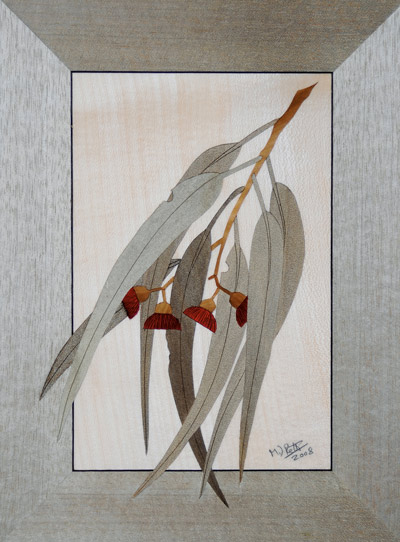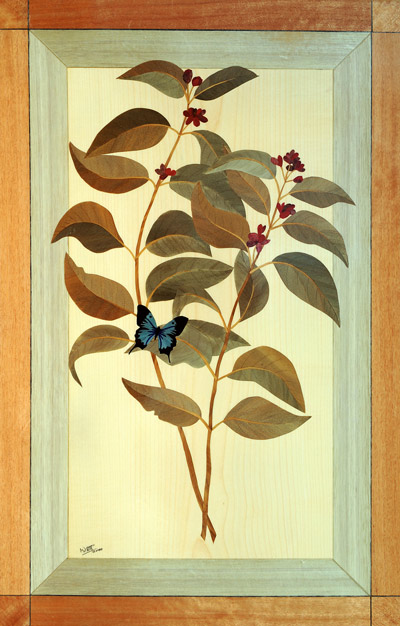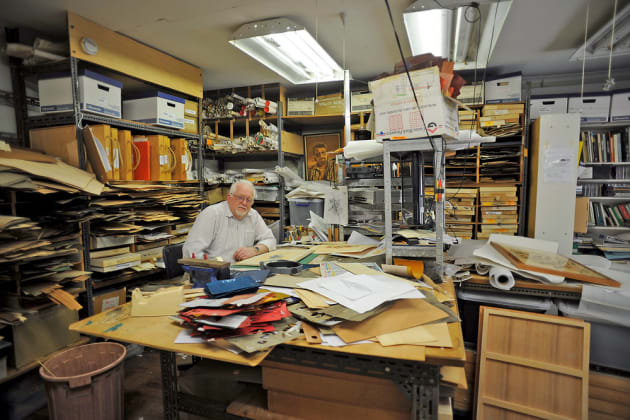Master of Marquetry
Words: Linda Nathan
Photos: Stan D’Argeaval
‘For most people technique is an end in itself,’ says Michael Retter, renowned marquetry artist. ‘They fall in love with a technique, work at improving it but then don’t see further into the creative side’, he explains. Easy to say perhaps when your own technique is immaculate, and you are known for a huge output of highly acclaimed marquetry ‘paintings’ produced over a 50 year span.
He explains: ‘It’s really just practice. I say to people: “just do some cutting, then cut for ten hours, then do it for 100 hours and you’ll see the difference”. There’s not that much you can teach people about marquetry; the technique is not complicated. The problem with woodworkers is that they get hung up on technique. If I have pictures in a gallery you can spot a woodworker when they come into the room from the way they look at them. The woodworkers will look straight at the mitre, not at the artwork.’

‘The designing is the real guts of it,’ continues Michael, who says he still has to work at it, pushing himself sometimes. Even with half a century of experience he bemoans the lack of a ‘formal education’, although with his list of credits this would seem to be irrelevant. ‘Marquetry is bit like politics—it’s the art of the possible, and there’s things you can’t do. You can’t do soft focus, although you might fluke a piece of wood which will give the effect of a misty background or something. Most marquetry you see is kitsch. When it comes to animals it’s difficult to produce designs that aren’t kitsch. With flora there’s no formality, so mistakes (broken corners, or over-sanding) can be repaired by adding a new ‘leaf’ or modifying a piece.’

As we looked at his own ‘younger’ self-portrait Michael explained how portraits can be difficult. It can be hard to please a client because the hard lines of marquetry can be aging. In fact to do someone’s portrait Michael may request a photo taken 15 years ago as a way of compensating. Remembering that the tracing for a portrait needs to be a mirror image (as for lettering) also adds a level of difficulty.

Michael tends to understate his own skill because the design of his work extends to an almost intuitive arrangement of the grain, figure and colour of each piece of veneer that is cut and pieced together. It’s as subtle as just rotating a piece of same coloured veneer a few degrees to achieve effects that border on holographic.
But where marquetry is concerned, colour is the big issue, and Michael has spent a lot of time dying batches of veneers into every shade of colour imaginable. A prism of dyed veneer squares labelled with batch numbers sits in boxes on the floor of his workshop. However the colours are non-repeatable because once a batch was finished Michael would add other colours to it. ‘You end up with gallons and gallons of muddy coloured stuff,’ he said.

Most of the brighter colours won’t be used except for detail work though, because it’s actually the ‘cold’ colours (blues, greens, greys) that he uses more of. These are the colours that are needed for depicting eucalypts and other natives. In a process akin to ebonising, Michael fills a wheelie bin with an iron sulphate solution. What ratio does he use? ‘I don’t know—I just chuck some in, it’s more to do with how much reactive substance is in the wood.’ The veneers are left to soak for about a week, then fished out and dotted around the garden until they are dry, but not so much that they wrinkle up. ‘Some wood stays nice and flat, but some of it’s cranky and you can’t do much about that,’ he says.

Kauri, poplar (aspen) and camphor laurel respond well to dying and ebonising. Kauri can also have a special lustre, which can quickly disappear if not sanded with care. Camphor laurel (‘the weed’) is ‘great stuff for marquetry’ because its variegated grain and colour stripes can be easily exploited. ‘Shading’ veneer pieces by slightly scorching them in hot sand is a traditional technique but not one that Michael tends to use. Sand shading will only produce browns and Michael is more of a colourist, selecting exact hues and gradations.

While colour and timber selection can be controlled to large degree, there is another potentially havoc-causing factor that can’t. With the sensitivity of a former merchant seaman, Michael keeps a close eye on his hygrometer, not to mention the wind. ‘I have a weather vane on the roof and if I think the wind is going to come from the west or north-west I know the humidity is going to nosedive and everything will dry out and wrinkle.’
With such a practised eye and hand you can be sure that Michael’s estimates for time needed will be close to the mark. For most woodworkers getting over over an obsession with technique is nothing that years of practice won’t cure.
See some insights into Michael's process here.
Michael Retter’s work sells at Bungendore Wood Works Gallery, NSW



